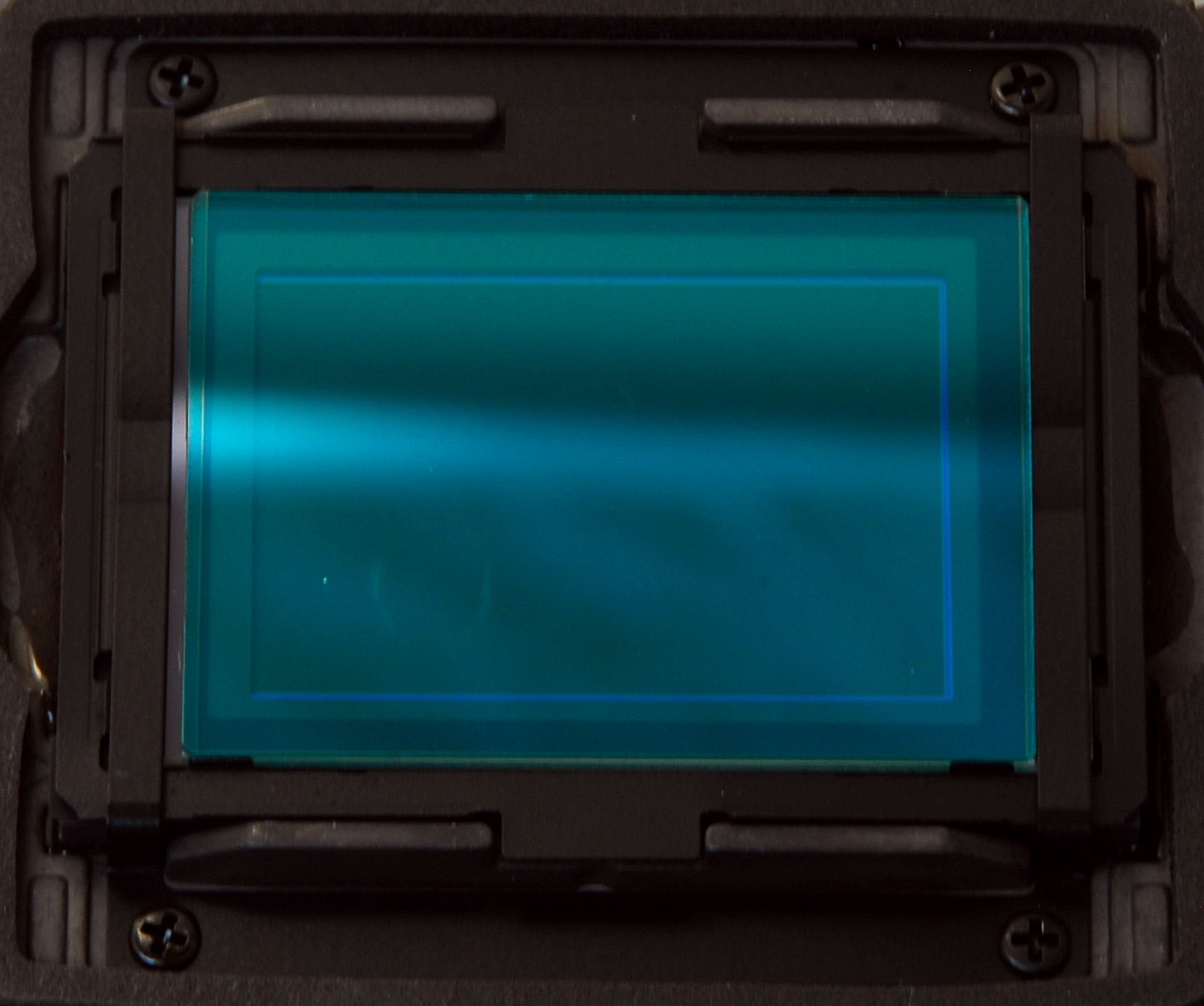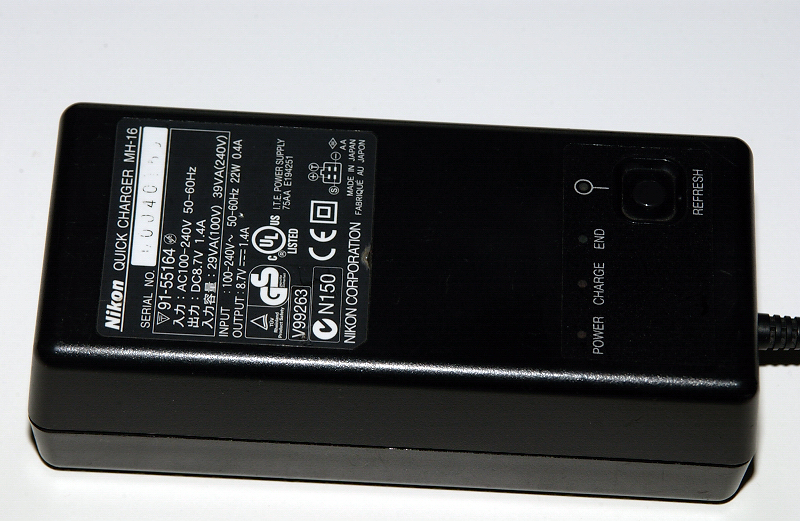Nikon D1 - D1X - D1H
The first Nikon digi-SLR, developed and made by Nikon itself - was introduced in 1999.
Nikon D1In June 1999 Nikon introduced this very nice digi-SLR, based on the body of the Nikon F5 and F-100. If you would be able to have a look inside the camera you would see the film compartment and space for the take-up spool for the film left intact.
The CCD-sensor - with the size close (23.7 x 15.6 mm.) to that of an APS-frame (18x24mm.), called DX - has a maximum resolution of 2.66 Megapixels (Mp), although a Nikon engineer stated in an interview that the CCD has more than 10 Mp, because all pixels were put in groups of 4 pixels, in order to avoid - among others - so called noise in the images. Special features are the fast 1/16,000 sec. shutter, 3D-Metering, AI-lens coupler, short shutter lag (60 ms.) and fast (4.5 fps) shooting option. This sturdy camera was meant for the professional photographer, who already had an arsenal of Nikkors and needed a rapid camera with a image resolution enough for a good print in his newspaper. After all nearly all pictures in newspapers and magazines are printed in 300 dpi, so more pixels aren´t really needed. Serial numbers from 5000001. Some 40,000 cameras were sold. When new this camera was extremely expensive, nowadays the camera is a bargain on many markets. If you want to buy one be aware of the fact that most cameras were used in tough circumstances by professional photographers. The paint on the body will tell you what this camera had to undergo. The rubber body covers come easily off, especially the rubber cover of the door, which leads to the CF-card chamber, is/was a disaster. Fortunately nearly all covers can still be ordered at Nikon Professional Service and can be glued on easily as the spare rubber covers are self-adhesive.
Serial number of the first Nikon D1 sold to the public in 1999!
To open the card door open first the little left door and push the button under it to release the lock of the larger right door. Be aware that all D1 camera versions take CompactFlash memory cards up to 2 Gb. only! There has never been issued a firmware or hardware upgrade for the Nikon D1 by Nikon Corporation. At the back of the camera you'll find the menu buttons, a little LCD window, a PC connector and an extra release button including a control dial and AF-button. At the front left you'll find the flash light connector (on top) and the 10-pins remote control connector; behind the rubber door is the video-out connector and the Nikon EH-4 AC-connector. Next to the lens mount is the lens release button and AF-selector. Please see the matrix for technical specifications and comparisons.
Nikon D1X - D1HNikon D1H + Nikon D1X
In summer 2001 these two cameras, almost identical to the Nikon D1, were introduced. Main difference with the Nikon D1 is the higher resolution of the CCD in the D1X (5.3 Mp) and the faster shooting option of the D1H: 5 fps. at a total burst of 40 frames. The CCD resolution of the D1H is the same as in the D1. The body and most software of these two newer ´sisters´ of the D1 are identical. Luckily a lot of accessories can be used, even the batteries (and thus the charger) and the net adapter! The D1X however eats up batteries, especially when the camera has his firmware/software update, which improves the burst rate and extends the internal memory buffer. It was/is also possible to buy some more memory, which has to be added to the hardware in the camera body. This operation (camera has to be opened and a memory stick has to be soldered) is relatively expensive. The standard EN-4 battery might be empty after 50 shots, as after the firmware upgrade the software in the camera will indicate a low battery earlier than in a camera without that upgrade! On internet several battery replacements with more power can be found. But..........be careful with no-name batteries as they may get very hot! All three cameras are using Compact Flash memory cards and IBM mini memory drives up to 2 Gb. CF-cards with a higher capacity will be 'seen' by the cameras as a 2Gb.card. If you want to use that card in a later Nikon digital SLR, like the Nikon D2 the card has to be formatted thoroughly. On the Nikon D1X and D1H camera functions can be seen and set on the large screen on the back. Serial numbers from 5100001 (D1X) and 5200001 (D1H). Production totals may be some 70,000 D1X's and approx. 26,000 D1H's. Note: the Nikon D1-series is NOT compatible with Windows Vista and later Windows software!! If you want to transfer images from your cards to a PC/laptop running under Windows Vista and later, you have to use a card reader. Direct camera to PC connection will not work!
Nikon EH-4 AC net adapter, usable with all D1 cameras.
Nikon MH-16 is the quick charger for only one battery
Nikon MH-17 car charger for one battery (in cars with 12 Volts circuit only!)
The manuals of both cameras are - also luckily - almost identical. Custom settings too, except custom setting 25 (page 176) is one rare difference, as it deals with the shooting speed. Second hand cameras are offered worldwide for relatively low prices, if one compare them with the prices when new (more than 6,000 Euro!). Be careful and check/inspect the LCD screens, mirror and the CCD sensor. The latter can be checked by taking a picture against a white background or just into the air. Dust and damages will appear as dark spots in the image, which should be enlarged in Nikon View (= Nikon´s software to transfer and manage images from a CF-card to a PC). Attention should be paid to the CF-card holder (pins inside) and all other connectors (including battery chamber). Unfortunately the rubber covers may become irreparably sticky. To check the firmware of the camera: put a CF-card in the camera, switch the camera on, take one picture and review the picture on the back screen. Press the selector button on the back on its right side some times until a text will appear. On the second line the version will be seen (1.01, 5.01 etc.) It is neither possible to find out the total number of shutter activations in the camera menu nor in Nikon View/Capture software or other freeware, like Opanda. You have to see an official Nikon service. See for a small colour test of the Nikon D1, D1X and D1H have a look here
|



